Screw Piles: Report on Design, Installation, and Performance Analysis
VerifiedAdded on 2020/05/11
|8
|1405
|127
Report
AI Summary
This report provides a comprehensive overview of screw piles, a type of deep foundation installed with minimal noise and vibration, similar to a screw inserted into wood. The report details the concept, including the circular steel sections with helices, and their application in various soil conditions, including earthquake zones. It discusses the advantages of screw piles such as quick installation, immediate load-carrying capacity, minimal site disturbance, and the ability to monitor installation torque. The report also outlines disadvantages, including restrictions on soil conditions, equipment limitations, and structural constraints. The conclusion summarizes screw piles as steel screw-in piling structures used for deep-rooted foundations, transferring structural loads into organized piles, and welded to the pile shaft for intended ground cases. The report includes references to relevant research papers.
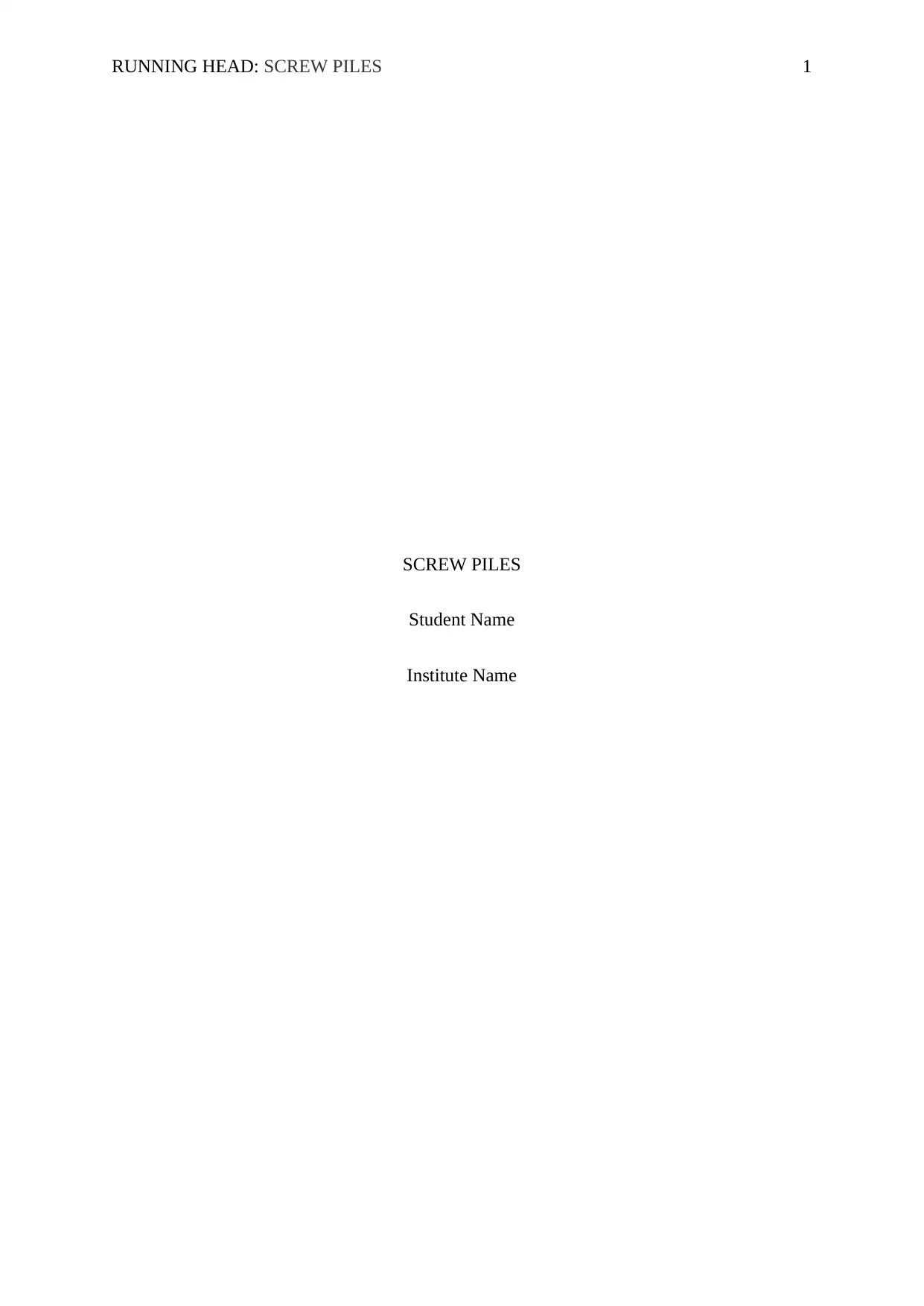
RUNNING HEAD: SCREW PILES 1
SCREW PILES
Student Name
Institute Name
SCREW PILES
Student Name
Institute Name
Paraphrase This Document
Need a fresh take? Get an instant paraphrase of this document with our AI Paraphraser
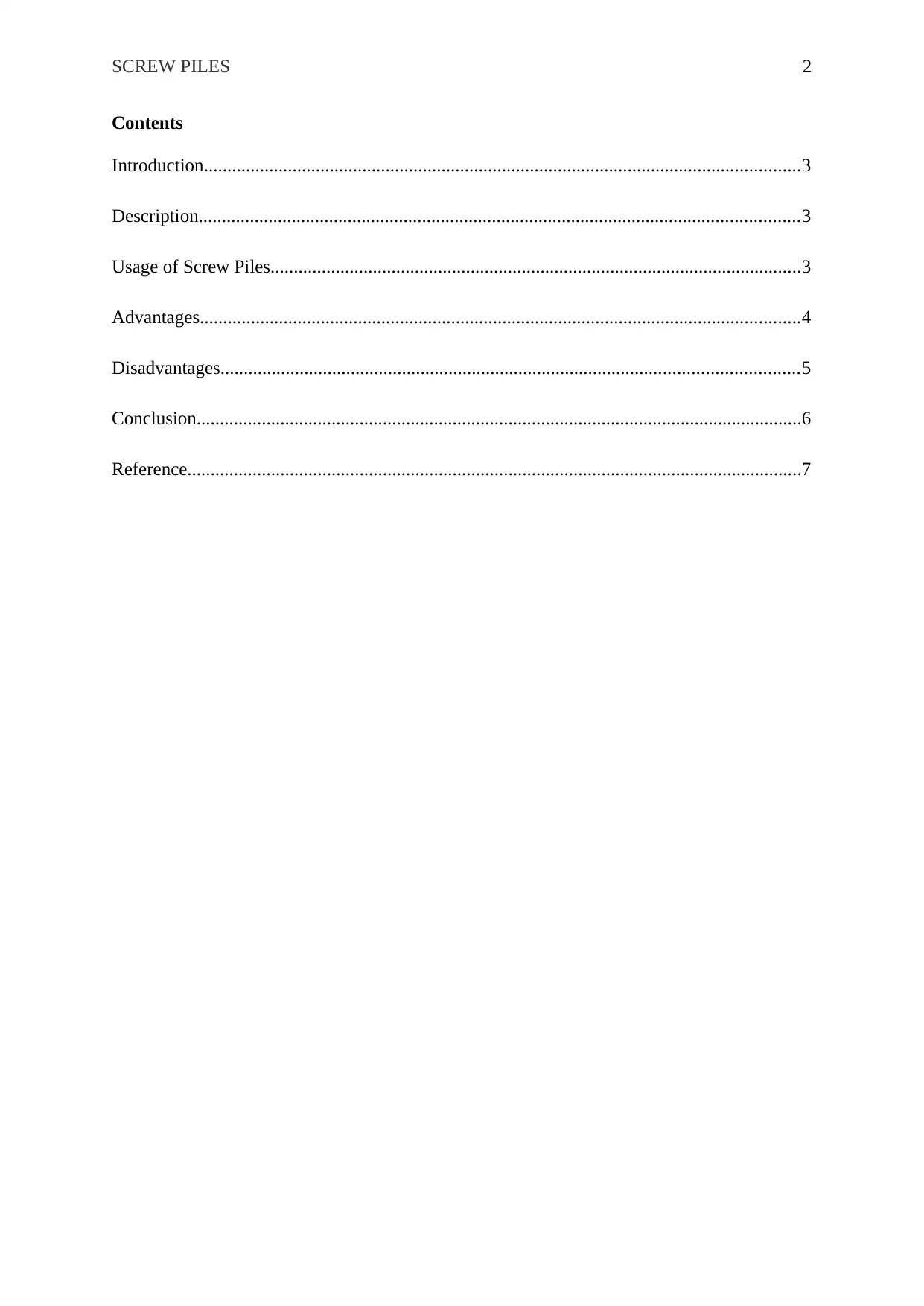
SCREW PILES 2
Contents
Introduction................................................................................................................................3
Description.................................................................................................................................3
Usage of Screw Piles..................................................................................................................3
Advantages.................................................................................................................................4
Disadvantages............................................................................................................................5
Conclusion..................................................................................................................................6
Reference....................................................................................................................................7
Contents
Introduction................................................................................................................................3
Description.................................................................................................................................3
Usage of Screw Piles..................................................................................................................3
Advantages.................................................................................................................................4
Disadvantages............................................................................................................................5
Conclusion..................................................................................................................................6
Reference....................................................................................................................................7
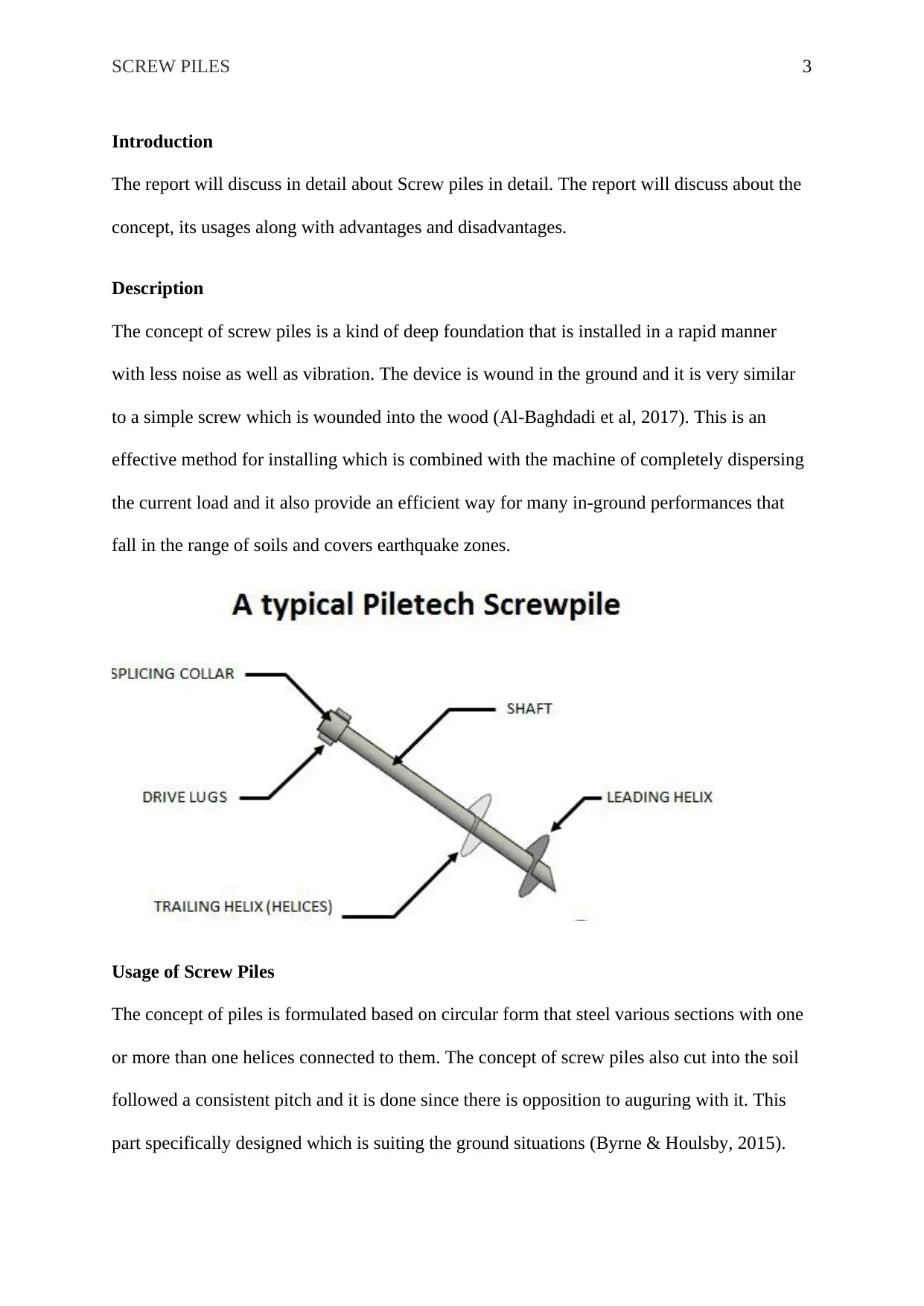
SCREW PILES 3
Introduction
The report will discuss in detail about Screw piles in detail. The report will discuss about the
concept, its usages along with advantages and disadvantages.
Description
The concept of screw piles is a kind of deep foundation that is installed in a rapid manner
with less noise as well as vibration. The device is wound in the ground and it is very similar
to a simple screw which is wounded into the wood (Al-Baghdadi et al, 2017). This is an
effective method for installing which is combined with the machine of completely dispersing
the current load and it also provide an efficient way for many in-ground performances that
fall in the range of soils and covers earthquake zones.
Usage of Screw Piles
The concept of piles is formulated based on circular form that steel various sections with one
or more than one helices connected to them. The concept of screw piles also cut into the soil
followed a consistent pitch and it is done since there is opposition to auguring with it. This
part specifically designed which is suiting the ground situations (Byrne & Houlsby, 2015).
Introduction
The report will discuss in detail about Screw piles in detail. The report will discuss about the
concept, its usages along with advantages and disadvantages.
Description
The concept of screw piles is a kind of deep foundation that is installed in a rapid manner
with less noise as well as vibration. The device is wound in the ground and it is very similar
to a simple screw which is wounded into the wood (Al-Baghdadi et al, 2017). This is an
effective method for installing which is combined with the machine of completely dispersing
the current load and it also provide an efficient way for many in-ground performances that
fall in the range of soils and covers earthquake zones.
Usage of Screw Piles
The concept of piles is formulated based on circular form that steel various sections with one
or more than one helices connected to them. The concept of screw piles also cut into the soil
followed a consistent pitch and it is done since there is opposition to auguring with it. This
part specifically designed which is suiting the ground situations (Byrne & Houlsby, 2015).
⊘ This is a preview!⊘
Do you want full access?
Subscribe today to unlock all pages.

Trusted by 1+ million students worldwide
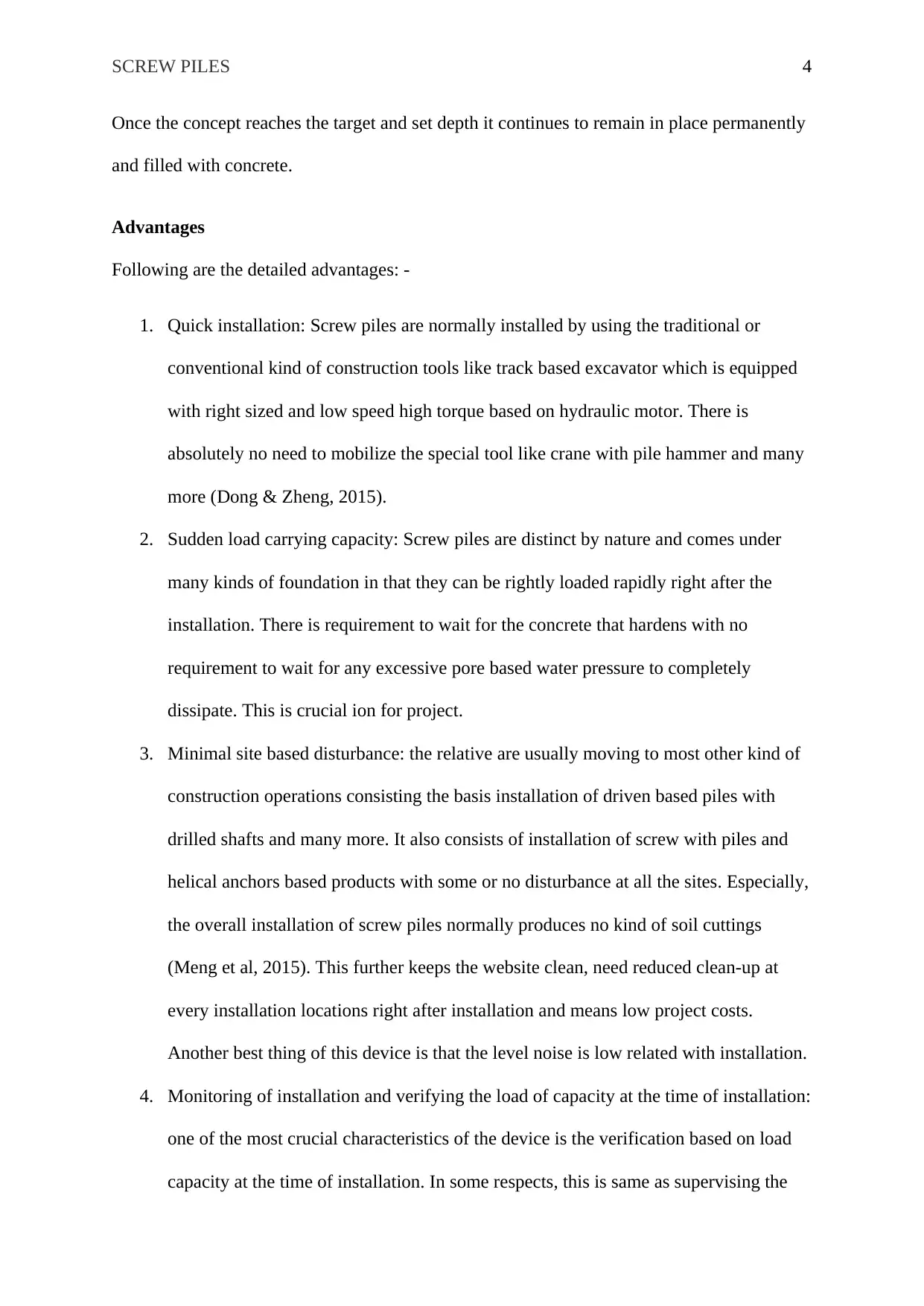
SCREW PILES 4
Once the concept reaches the target and set depth it continues to remain in place permanently
and filled with concrete.
Advantages
Following are the detailed advantages: -
1. Quick installation: Screw piles are normally installed by using the traditional or
conventional kind of construction tools like track based excavator which is equipped
with right sized and low speed high torque based on hydraulic motor. There is
absolutely no need to mobilize the special tool like crane with pile hammer and many
more (Dong & Zheng, 2015).
2. Sudden load carrying capacity: Screw piles are distinct by nature and comes under
many kinds of foundation in that they can be rightly loaded rapidly right after the
installation. There is requirement to wait for the concrete that hardens with no
requirement to wait for any excessive pore based water pressure to completely
dissipate. This is crucial ion for project.
3. Minimal site based disturbance: the relative are usually moving to most other kind of
construction operations consisting the basis installation of driven based piles with
drilled shafts and many more. It also consists of installation of screw with piles and
helical anchors based products with some or no disturbance at all the sites. Especially,
the overall installation of screw piles normally produces no kind of soil cuttings
(Meng et al, 2015). This further keeps the website clean, need reduced clean-up at
every installation locations right after installation and means low project costs.
Another best thing of this device is that the level noise is low related with installation.
4. Monitoring of installation and verifying the load of capacity at the time of installation:
one of the most crucial characteristics of the device is the verification based on load
capacity at the time of installation. In some respects, this is same as supervising the
Once the concept reaches the target and set depth it continues to remain in place permanently
and filled with concrete.
Advantages
Following are the detailed advantages: -
1. Quick installation: Screw piles are normally installed by using the traditional or
conventional kind of construction tools like track based excavator which is equipped
with right sized and low speed high torque based on hydraulic motor. There is
absolutely no need to mobilize the special tool like crane with pile hammer and many
more (Dong & Zheng, 2015).
2. Sudden load carrying capacity: Screw piles are distinct by nature and comes under
many kinds of foundation in that they can be rightly loaded rapidly right after the
installation. There is requirement to wait for the concrete that hardens with no
requirement to wait for any excessive pore based water pressure to completely
dissipate. This is crucial ion for project.
3. Minimal site based disturbance: the relative are usually moving to most other kind of
construction operations consisting the basis installation of driven based piles with
drilled shafts and many more. It also consists of installation of screw with piles and
helical anchors based products with some or no disturbance at all the sites. Especially,
the overall installation of screw piles normally produces no kind of soil cuttings
(Meng et al, 2015). This further keeps the website clean, need reduced clean-up at
every installation locations right after installation and means low project costs.
Another best thing of this device is that the level noise is low related with installation.
4. Monitoring of installation and verifying the load of capacity at the time of installation:
one of the most crucial characteristics of the device is the verification based on load
capacity at the time of installation. In some respects, this is same as supervising the
Paraphrase This Document
Need a fresh take? Get an instant paraphrase of this document with our AI Paraphraser
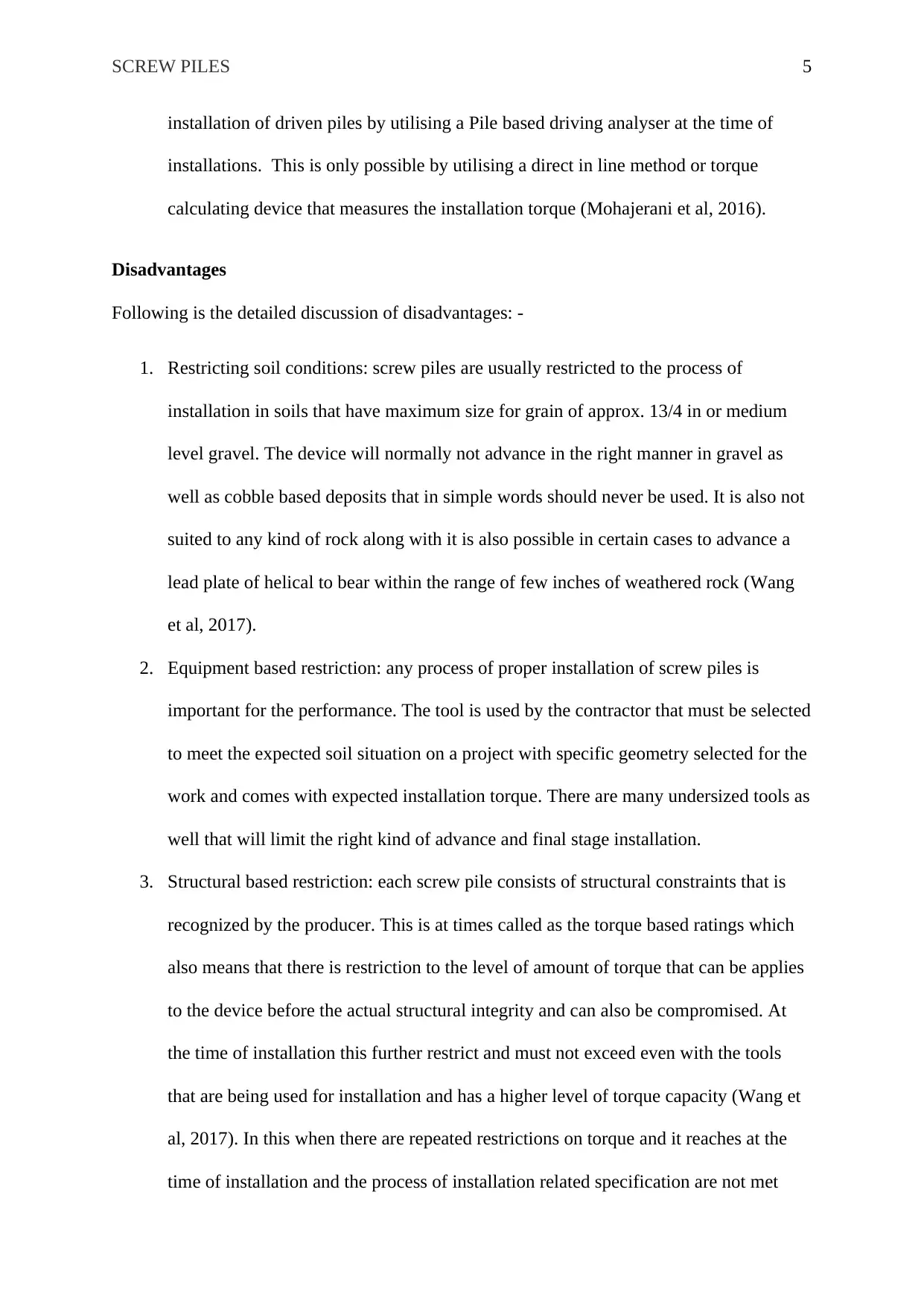
SCREW PILES 5
installation of driven piles by utilising a Pile based driving analyser at the time of
installations. This is only possible by utilising a direct in line method or torque
calculating device that measures the installation torque (Mohajerani et al, 2016).
Disadvantages
Following is the detailed discussion of disadvantages: -
1. Restricting soil conditions: screw piles are usually restricted to the process of
installation in soils that have maximum size for grain of approx. 13/4 in or medium
level gravel. The device will normally not advance in the right manner in gravel as
well as cobble based deposits that in simple words should never be used. It is also not
suited to any kind of rock along with it is also possible in certain cases to advance a
lead plate of helical to bear within the range of few inches of weathered rock (Wang
et al, 2017).
2. Equipment based restriction: any process of proper installation of screw piles is
important for the performance. The tool is used by the contractor that must be selected
to meet the expected soil situation on a project with specific geometry selected for the
work and comes with expected installation torque. There are many undersized tools as
well that will limit the right kind of advance and final stage installation.
3. Structural based restriction: each screw pile consists of structural constraints that is
recognized by the producer. This is at times called as the torque based ratings which
also means that there is restriction to the level of amount of torque that can be applies
to the device before the actual structural integrity and can also be compromised. At
the time of installation this further restrict and must not exceed even with the tools
that are being used for installation and has a higher level of torque capacity (Wang et
al, 2017). In this when there are repeated restrictions on torque and it reaches at the
time of installation and the process of installation related specification are not met
installation of driven piles by utilising a Pile based driving analyser at the time of
installations. This is only possible by utilising a direct in line method or torque
calculating device that measures the installation torque (Mohajerani et al, 2016).
Disadvantages
Following is the detailed discussion of disadvantages: -
1. Restricting soil conditions: screw piles are usually restricted to the process of
installation in soils that have maximum size for grain of approx. 13/4 in or medium
level gravel. The device will normally not advance in the right manner in gravel as
well as cobble based deposits that in simple words should never be used. It is also not
suited to any kind of rock along with it is also possible in certain cases to advance a
lead plate of helical to bear within the range of few inches of weathered rock (Wang
et al, 2017).
2. Equipment based restriction: any process of proper installation of screw piles is
important for the performance. The tool is used by the contractor that must be selected
to meet the expected soil situation on a project with specific geometry selected for the
work and comes with expected installation torque. There are many undersized tools as
well that will limit the right kind of advance and final stage installation.
3. Structural based restriction: each screw pile consists of structural constraints that is
recognized by the producer. This is at times called as the torque based ratings which
also means that there is restriction to the level of amount of torque that can be applies
to the device before the actual structural integrity and can also be compromised. At
the time of installation this further restrict and must not exceed even with the tools
that are being used for installation and has a higher level of torque capacity (Wang et
al, 2017). In this when there are repeated restrictions on torque and it reaches at the
time of installation and the process of installation related specification are not met
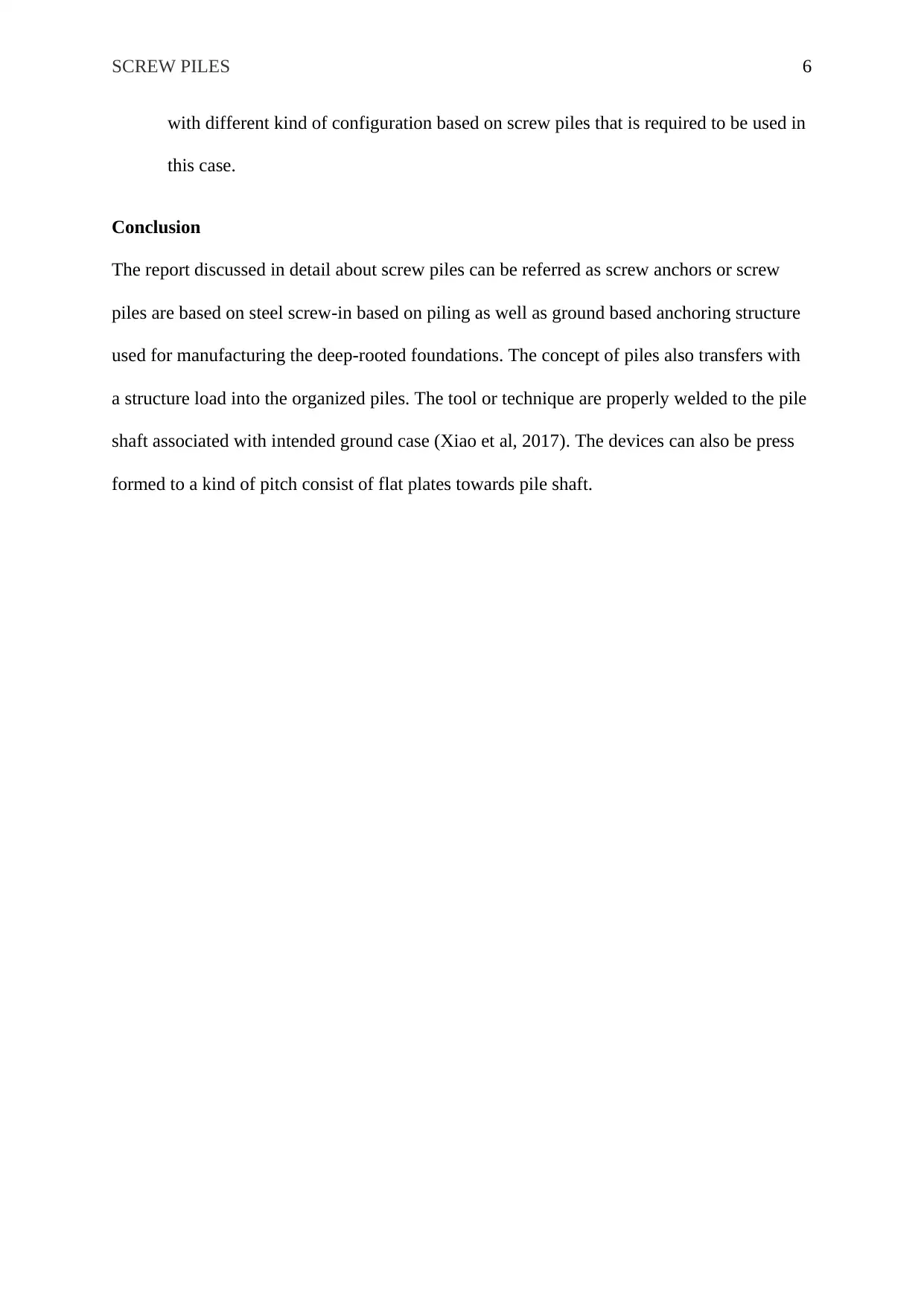
SCREW PILES 6
with different kind of configuration based on screw piles that is required to be used in
this case.
Conclusion
The report discussed in detail about screw piles can be referred as screw anchors or screw
piles are based on steel screw-in based on piling as well as ground based anchoring structure
used for manufacturing the deep-rooted foundations. The concept of piles also transfers with
a structure load into the organized piles. The tool or technique are properly welded to the pile
shaft associated with intended ground case (Xiao et al, 2017). The devices can also be press
formed to a kind of pitch consist of flat plates towards pile shaft.
with different kind of configuration based on screw piles that is required to be used in
this case.
Conclusion
The report discussed in detail about screw piles can be referred as screw anchors or screw
piles are based on steel screw-in based on piling as well as ground based anchoring structure
used for manufacturing the deep-rooted foundations. The concept of piles also transfers with
a structure load into the organized piles. The tool or technique are properly welded to the pile
shaft associated with intended ground case (Xiao et al, 2017). The devices can also be press
formed to a kind of pitch consist of flat plates towards pile shaft.
⊘ This is a preview!⊘
Do you want full access?
Subscribe today to unlock all pages.

Trusted by 1+ million students worldwide
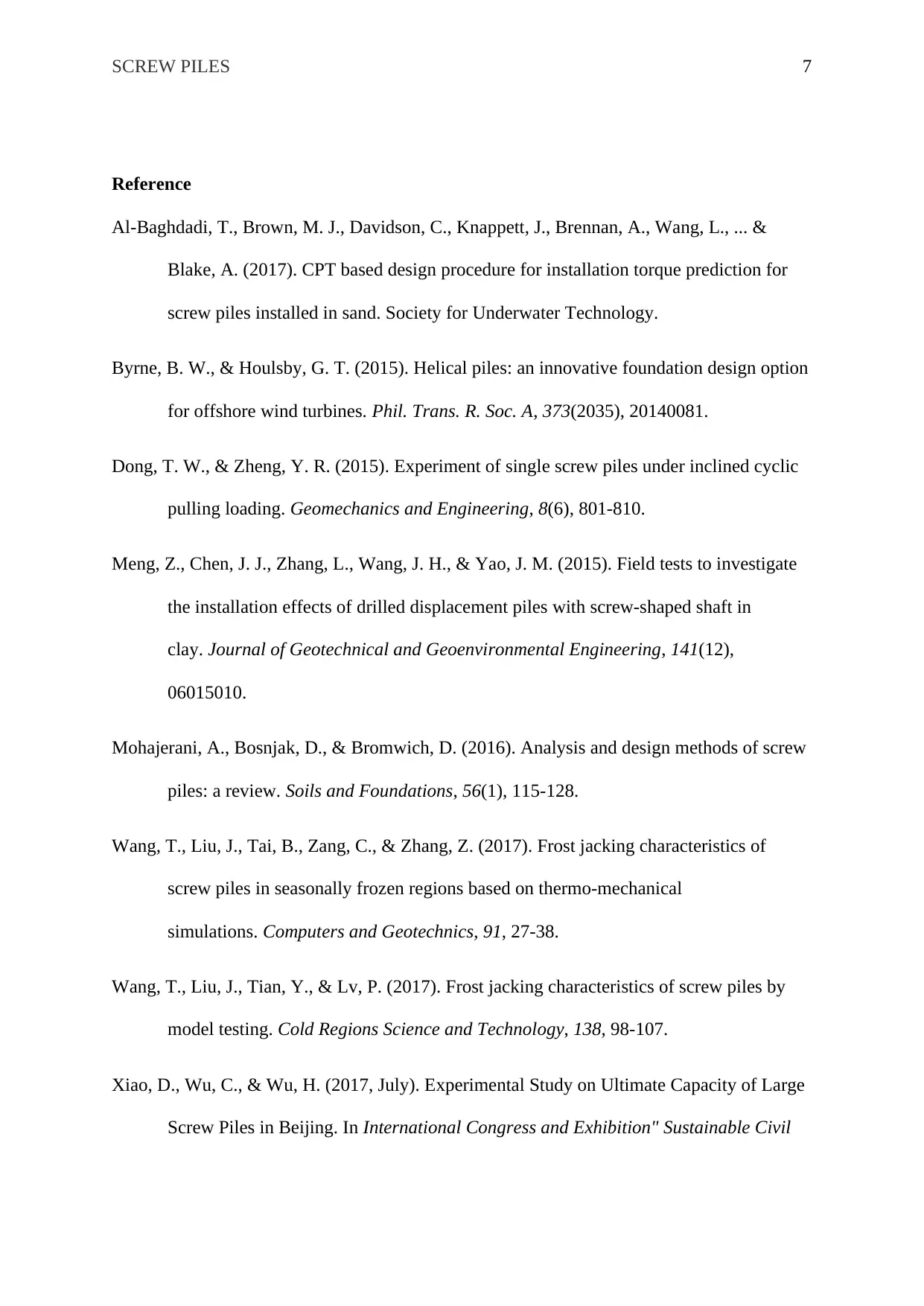
SCREW PILES 7
Reference
Al-Baghdadi, T., Brown, M. J., Davidson, C., Knappett, J., Brennan, A., Wang, L., ... &
Blake, A. (2017). CPT based design procedure for installation torque prediction for
screw piles installed in sand. Society for Underwater Technology.
Byrne, B. W., & Houlsby, G. T. (2015). Helical piles: an innovative foundation design option
for offshore wind turbines. Phil. Trans. R. Soc. A, 373(2035), 20140081.
Dong, T. W., & Zheng, Y. R. (2015). Experiment of single screw piles under inclined cyclic
pulling loading. Geomechanics and Engineering, 8(6), 801-810.
Meng, Z., Chen, J. J., Zhang, L., Wang, J. H., & Yao, J. M. (2015). Field tests to investigate
the installation effects of drilled displacement piles with screw-shaped shaft in
clay. Journal of Geotechnical and Geoenvironmental Engineering, 141(12),
06015010.
Mohajerani, A., Bosnjak, D., & Bromwich, D. (2016). Analysis and design methods of screw
piles: a review. Soils and Foundations, 56(1), 115-128.
Wang, T., Liu, J., Tai, B., Zang, C., & Zhang, Z. (2017). Frost jacking characteristics of
screw piles in seasonally frozen regions based on thermo-mechanical
simulations. Computers and Geotechnics, 91, 27-38.
Wang, T., Liu, J., Tian, Y., & Lv, P. (2017). Frost jacking characteristics of screw piles by
model testing. Cold Regions Science and Technology, 138, 98-107.
Xiao, D., Wu, C., & Wu, H. (2017, July). Experimental Study on Ultimate Capacity of Large
Screw Piles in Beijing. In International Congress and Exhibition" Sustainable Civil
Reference
Al-Baghdadi, T., Brown, M. J., Davidson, C., Knappett, J., Brennan, A., Wang, L., ... &
Blake, A. (2017). CPT based design procedure for installation torque prediction for
screw piles installed in sand. Society for Underwater Technology.
Byrne, B. W., & Houlsby, G. T. (2015). Helical piles: an innovative foundation design option
for offshore wind turbines. Phil. Trans. R. Soc. A, 373(2035), 20140081.
Dong, T. W., & Zheng, Y. R. (2015). Experiment of single screw piles under inclined cyclic
pulling loading. Geomechanics and Engineering, 8(6), 801-810.
Meng, Z., Chen, J. J., Zhang, L., Wang, J. H., & Yao, J. M. (2015). Field tests to investigate
the installation effects of drilled displacement piles with screw-shaped shaft in
clay. Journal of Geotechnical and Geoenvironmental Engineering, 141(12),
06015010.
Mohajerani, A., Bosnjak, D., & Bromwich, D. (2016). Analysis and design methods of screw
piles: a review. Soils and Foundations, 56(1), 115-128.
Wang, T., Liu, J., Tai, B., Zang, C., & Zhang, Z. (2017). Frost jacking characteristics of
screw piles in seasonally frozen regions based on thermo-mechanical
simulations. Computers and Geotechnics, 91, 27-38.
Wang, T., Liu, J., Tian, Y., & Lv, P. (2017). Frost jacking characteristics of screw piles by
model testing. Cold Regions Science and Technology, 138, 98-107.
Xiao, D., Wu, C., & Wu, H. (2017, July). Experimental Study on Ultimate Capacity of Large
Screw Piles in Beijing. In International Congress and Exhibition" Sustainable Civil
Paraphrase This Document
Need a fresh take? Get an instant paraphrase of this document with our AI Paraphraser
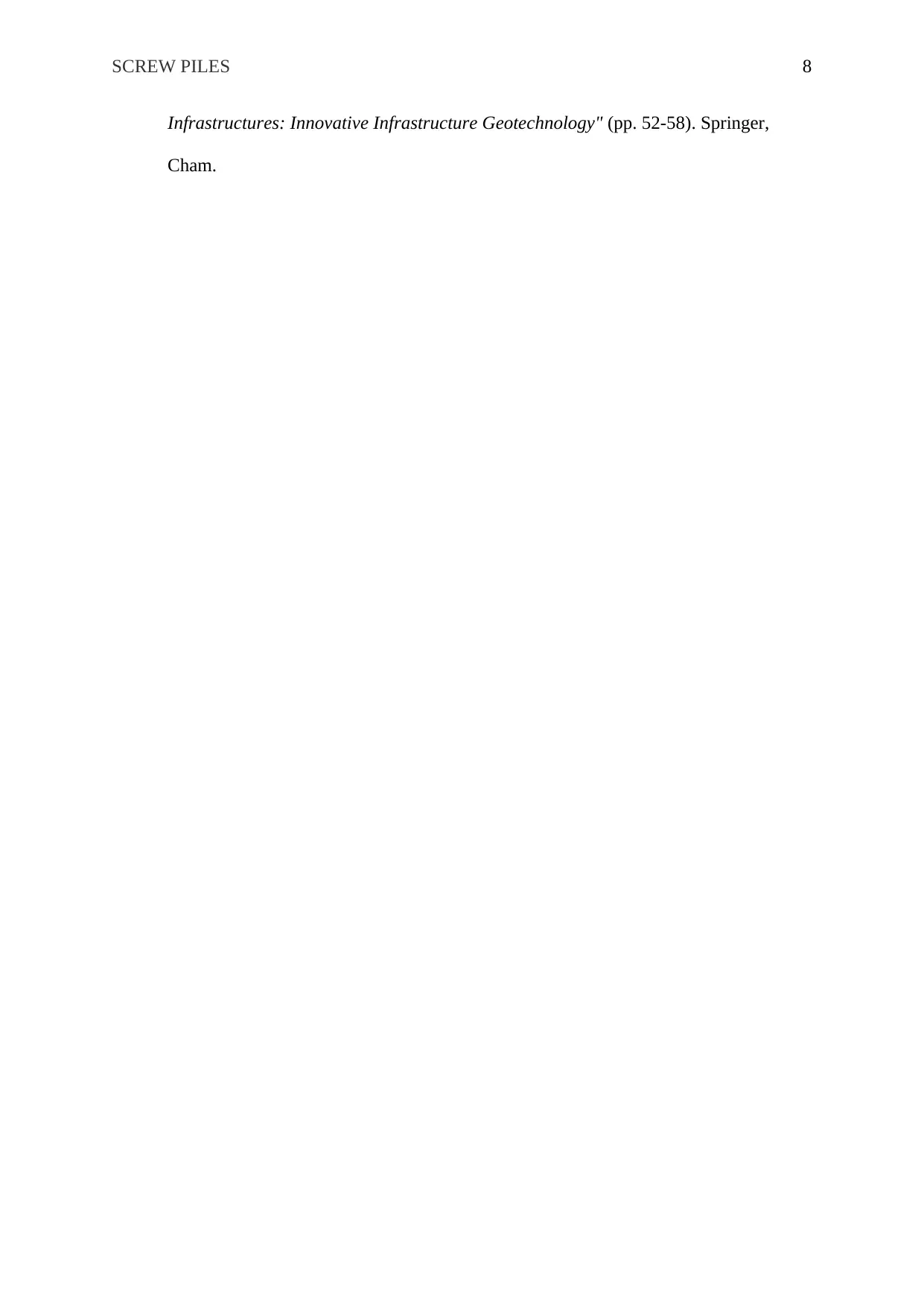
SCREW PILES 8
Infrastructures: Innovative Infrastructure Geotechnology" (pp. 52-58). Springer,
Cham.
Infrastructures: Innovative Infrastructure Geotechnology" (pp. 52-58). Springer,
Cham.
1 out of 8
Your All-in-One AI-Powered Toolkit for Academic Success.
+13062052269
info@desklib.com
Available 24*7 on WhatsApp / Email
![[object Object]](/_next/static/media/star-bottom.7253800d.svg)
Unlock your academic potential
Copyright © 2020–2025 A2Z Services. All Rights Reserved. Developed and managed by ZUCOL.